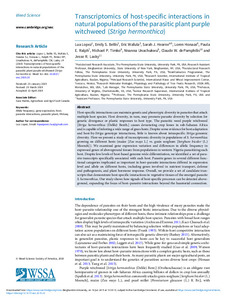| dc.contributor.author | Lopez, L. |
| dc.contributor.author | Bellis, E.S. |
| dc.contributor.author | Wafula, E. |
| dc.contributor.author | Hearne, S. |
| dc.contributor.author | Honaas, L. |
| dc.contributor.author | Ralph, P.E. |
| dc.contributor.author | Timko, M.P. |
| dc.contributor.author | Unachukwu, N. |
| dc.contributor.author | dePamphilis, C.W. |
| dc.contributor.author | Lasky, J.R. |
| dc.date.accessioned | 2022-08-08T08:08:04Z |
| dc.date.available | 2022-08-08T08:08:04Z |
| dc.date.issued | 2019-07 |
| dc.identifier.citation | Lopez, L., Bellis, E.S., Wafula, E., Hearne, S.J., Honaas, L., Ralph, P.E., ... & Lasky, J.R. (2019). Transcriptomics of host-specific interactions in natural populations of the parasitic plant purple witchweed (Striga hermonthica). Weed Science, 67(4), 397-411. |
| dc.identifier.issn | 0043-1745 |
| dc.identifier.uri | https://hdl.handle.net/20.500.12478/7611 |
| dc.description.abstract | Host-specific interactions can maintain genetic and phenotypic diversity in parasites that attack multiple host species. Host diversity, in turn, may promote parasite diversity by selection for genetic divergence or plastic responses to host type. The parasitic weed purple witchweed [Striga hermonthica (Delile) Benth.] causes devastating crop losses in sub-Saharan Africa and is capable of infesting a wide range of grass hosts. Despite some evidence for host adaptation and host-by-Striga genotype interactions, little is known about intraspecific Striga genomic diversity. Here we present a study of transcriptomic diversity in populations of S. hermonthica growing on different hosts (maize [Zea mays L.] vs. grain sorghum [Sorghum bicolor (L.) Moench]). We examined gene expression variation and differences in allelic frequency in expressed genes of aboveground tissues from populations in western Nigeria parasitizing each host. Despite low levels of host-based genome-wide differentiation, we identified a set of parasite transcripts specifically associated with each host. Parasite genes in several different functional categories implicated as important in host–parasite interactions differed in expression level and allele on different hosts, including genes involved in nutrient transport, defense and pathogenesis, and plant hormone response. Overall, we provide a set of candidate transcripts that demonstrate host-specific interactions in vegetative tissues of the emerged parasite S. hermonthica. Our study shows how signals of host-specific processes can be detected aboveground, expanding the focus of host–parasite interactions beyond the haustorial connection. |
| dc.format.extent | 397-411 |
| dc.language.iso | en |
| dc.subject | Allele Frequency |
| dc.subject | Gene Expression |
| dc.subject | Host Parasite Relations |
| dc.subject | Parasitic Plant |
| dc.subject | RNA Sequence |
| dc.subject | Maize |
| dc.subject | Striga Hermonthica |
| dc.title | Transcriptomics of host-specific interactions in natural populations of the parasitic plant purple witchweed (Striga hermonthica) |
| dc.type | Journal Article |
| cg.contributor.affiliation | The Pennsylvania State University |
| cg.contributor.affiliation | International Institute of Tropical Agriculture |
| cg.contributor.affiliation | International Maize and Wheat Improvement Center |
| cg.contributor.affiliation | United States Department of Agriculture |
| cg.contributor.affiliation | University of Virginia |
| cg.coverage.region | Africa |
| cg.coverage.region | West Africa |
| cg.coverage.country | Nigeria |
| cg.coverage.hub | Headquarters and Western Africa Hub |
| cg.identifier.bibtexciteid | LOPEZ:2019 |
| cg.isijournal | ISI Journal |
| cg.authorship.types | CGIAR and advanced research institute |
| cg.iitasubject | Food Security |
| cg.iitasubject | Maize |
| cg.iitasubject | Plant Diseases |
| cg.iitasubject | Plant Health |
| cg.journal | Weed Science |
| cg.notes | Published online: 10 June 2019 |
| cg.accessibilitystatus | Limited Access |
| cg.reviewstatus | Peer Review |
| cg.usagerightslicense | Copyrighted; all rights reserved |
| cg.targetaudience | Scientists |
| cg.identifier.doi | https://dx.doi.org/10.1017/%20wsc.2019.20 |
| cg.futureupdate.required | No |
| cg.identifier.issue | 4 |
| cg.identifier.volume | 67 |

